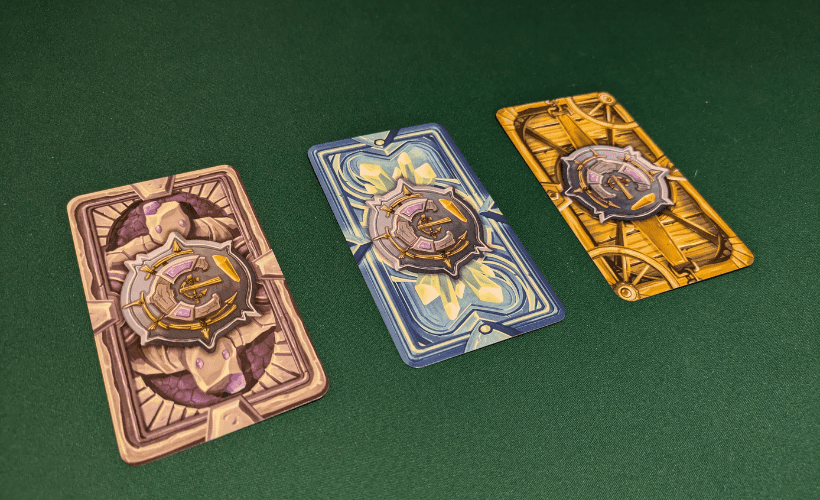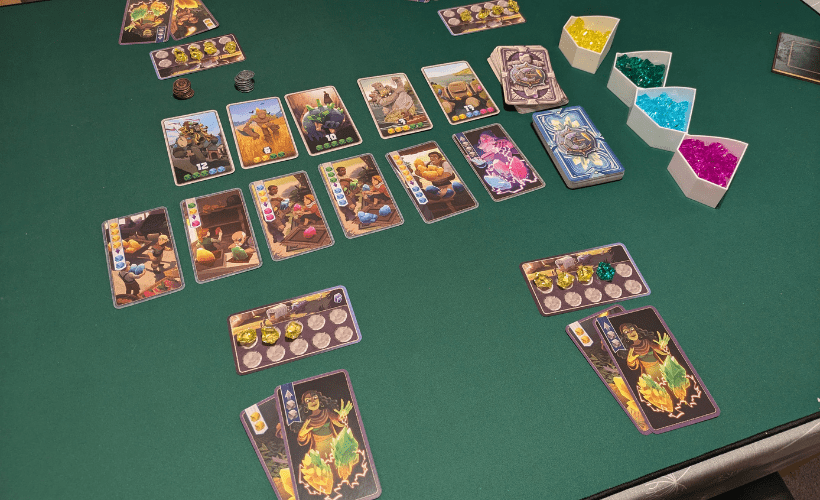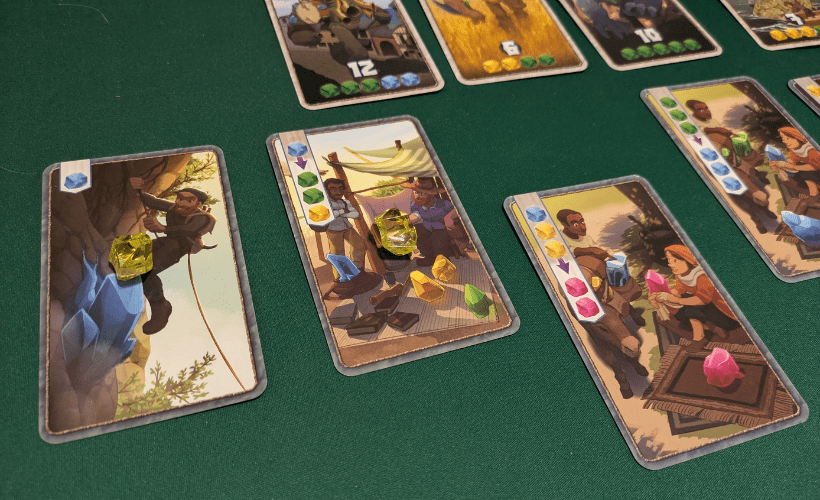






Century: Golem Edition
Awards
Rating
-
Artwork
-
Complexity
-
Replayability
-
Player Interaction
-
Component Quality
You Might Like
- The art work and components are a step up from the original.
- Same accessible gameplay.
- Quick to set-up and play.
Might Not Like
- No planned trilogy.
- The same game as Spice Road.
- Low player interaction.
Related Products
Description
The Century trilogy of games from designer Emerson Matsuuchi and Plan B Games are something of an enigma. Starting life as a planned trilogy of games with two different themes, spice trading and um... Golems. After retail pre-orders overwhelmingly favoured the spice theme, the Golems were dropped. But you can’t keep a good Golem down and eventually, after much fan pressure and many official denials, the Golems Edition was reborn. It now appears, again after many denials, that it will indeed be a complete trilogy too.
If you have played Spice Road you know exactly what to expect. The gameplay is literally the same. For those who don’t, the essence of the game is obtaining resources and then manipulating and exchanging them into other resources to fulfil orders. How this relates to Golems is unclear, but it’s certainly more interesting than spice trading!
You will use hand management to gain and use cards that let you turn lots of less valuable resources into a few precious resources and vice versa. Each turn, you will fulfil orders, gain new exchange cards, play a card or recover all played cards into your hand. The key is to get cards into your hand that give you flexibility to change resources at will. Easier said than done when each time you play a card it stays on the table until you pick up all your cards.
As per Spice Road, the components are great. In fact, we’d argue they are better in this version, with plastic gemstones replacing the wooden cubes and an art style reminiscent of manga replacing the rather uninspired trading scenes from Spice Road. Originally, the thing that stopped many buying Golem Edition was the uncertainty that there would be a ‘Golem trilogy’ but with the release of Golem Eastern Mountains this looks to be a non-issue.
Player Count: 2-5
Time: 30-45 Minutes
Age: 8+ UNBOXING Review UNBOXING

It’s hard to define what makes a game qualify to be hot, but Century: Spice Road has definitely had it. Maybe it’s the promise of gateway goodness, pretty components and fast play. Maybe it was the comparisons to the lightweight accessible darling of the board game scene, Splendor, or maybe it was just the certain je ne sais quoi.
Whatever it is, there is no denying that Plan B Games’ Spice Road has made it’s mark as an accessible Splendor-like game with added depth. Does the Golem Edition change that?
Golem Edition
Century: Spice Road started life as Caravan, the game was fundamentally the same but was planned to be released with two themes, the one we have now, and a Crystal Golem version that was sadly ditched. Now Spice Road is the first of the ‘Century’ trilogy. Then the internet spoke and the Golem Edition was reborn!
The game plays exactly the same way as Spice Road, but for those out of the loop let’s catch you up. You start the game by laying out a row of five goal cards, and six merchant cards. Goal cards offer you victory points for trading in various crystals and the two leftmost cards have lovely metal coins placed above them for anyone game enough to grab those cards.

When a card is gained the cards move left to fill the gaps and a new goal is drawn from the deck. Merchant cards allow you to gain and manipulate your crystals in order to earn those victory points. Most Merchant cards allow you to trade a number of crystals for another amount of crystals, for example you might be able to trade three yellow crystals for two green crystals, and you are able to do this as many times as you have the initial resource.
Other cards simply produce crystals and finally other cards allow you to upgrade crystals (Yellow-Green-Blue-Pink). The Merchant card on the far left is free, but any kind to the right of that must be paid for by laying one crystal of your choice on each card to the right of it. This is one of my favourite parts of Century – should I cough up my hard earned crystals to get that shiny card that would really help me, or do I use them to fulfil that points card and move closer to the end game.
Crystals for my Spice
Each player starts with one production card and one upgrade card, before choosing one of four actions each turn. Play a card from your hand and do what it says, this card stays on the table until you take the rest action which allows you to pick up all your cards into your hand again, with the remaining two actions being to take one of the two card types from the rows on the table.
All of this results in a kind of slow moving adaptable engine building game, which feels like a deck building game where you get to keep all your cards rather than ditch the guff ones. Comparisons to Splendor are rash on the one hand and apt on the other. There is a sense of gaining more valuable stuff as you go but unlike Splendor, at some point you are going to have to rest and start again. Splendor let’s you build your efforts as cards purchased become jewels for future buys, Century is more about using the cards you have to manipulate crystals to your wants, sometimes being thwarted by other players, but sometimes being the thwarter!
Keeping an eye on your opponent’s crystal reserves is essential, because you may notice that they will reach your shared goal first and therefore be able to change your plans, or that no one else is anyway near that points card so you can start building for the next one too.
Despite the decisions on display I never felt under or overwhelmed. Whether my plans were in tact or had to be adapted there was nearly always something I wanted to do and more importantly was worth doing. At four players the game positively sprints by as players are a turn-taking blur of card and crystal grabbing before cashing in. Some players slow this down but by in large when your turn comes round you know exactly what you want to do.

My Precious
So far so good? Right? Well….. there are a few niggling issues. The history of this game shows that the theme is lightly tacked on at best. They are called crystals but in play people just resort to saying ‘Chuck me a green gem’. The components, though lovely, don’t really add to the theme and for £30 it feels a bit like you are paying for plastic bowls and metal coins (nice as they are) and I wonder how this might have been as a £20 game with cheaper components, and a more appropriate box size, as just like Splendor there is a lot of room here when you remove the insert. However the insert is much better than the Spice Road version in terms of lay out and keeping all the bits in the relevant places.
While there is, in my opinion, more depth here than Splendor without much of a learning spike, this doesn’t lift it from a ‘gateway level’. If you are looking for something with a lot more depth you won’t find it here, and perhaps part of the reason is the biggest problem with the game – the balance of merchant cards. The production cards that essentially give you crystals are very few in the deck, worse still there appears to be only one upgrade card available outside of the starting cards. This means these cards are always targeted by crafty players and can be hard to compete against.
Lastly on the negatives, I have heard that this is not a great game for colourblind people, depending on the colours you struggle with.
Summarising the Golem Edition
In summary, Century: Golem Edition is a great game to play with game groups and newcomers alike, with quick, thoughtful play that is ultimately rewarding. It’s not a perfect game, but it probably deserves a modicum of the buzz it has created. Should you buy it over Spice Road? Well, we will save that for another article!

Century Golem is a re-theme of the game Century: Spice Road, where in this version you are trying to collect and trade Gems to acquire cards with Golems to earn victory points.
Set-Up
Separate the cards into their different types, Point Cards with purple backs featuring a golem, Merchant Cars with a blue back featuring a crystal Design, and Caravan Cards which have a light brown back with a wooden design featuring wheels.

Shuffle the Point cards into a deck and deal 5 face up into a row in the middle of the play area, placing the remaining deck face down at the right end of the row.
Find the copper tokens and place two per player in a pile above the leftmost card in the point row (furthest from the face-down deck). Then find the silver tokens and place two per player above the card second from the left (the card next to the one with the copper tokens).
Look through the merchant deck and find the 10 cards that feature a purple border on their faces, there will be 5 cards in two types one called Create Two which will have two yellow crystals in the top left corner and feature art of an explored finding two crystal clusters, and Upgrade Two which has two grey crystals with an arrow above it in the top left corners featuring art of a dark haired woman with magic coming out of her hand and two crystal clusters that are half yellow and half green. These are the two starting cards, give one of each to each player, returning any remaining to the box.

Shuffle the rest of the merchant cards into a deck and deal a row of 6 cards below the Point card row placing the remaining deck face down to the right of the row.
Place the 4 crystal colours in the diamond-shaped bowls in the play area in order of value from lowest to highest Yellow > Green > Blue > Pink
Take as many caravan cards as players in your game, making sure to include the caravan with a crystal symbol in the top right of the card within the ones you are using, and return any remaining to the box. Shuffle these together and randomly deal one to each player, which ever player ends up with the caravan with the crystal symbol is the starting player. Each player places their caravan card face up in front of them.
 Give each player their starting crystals to place into their caravan based on the list below, turn order going clockwise around the players:
Give each player their starting crystals to place into their caravan based on the list below, turn order going clockwise around the players:1st Player – 3 Yellow Crystals
2nd and 3rd Player – 4 Yellow Crystals
4th and 5th Player – 3 Yellow Crystals and 1 Green Crystal
You are now set up and ready to play the game.

Game Play
Century Golem Edition is played over a series of rounds until the game end is triggered. Each player takes one turn a round starting with the player with the first player and continuing clockwise.
On a player’s turn they can take one of four actions:Play – play a card from their hand.
Acquire – gain a merchant card.
Rest – take all previously played cards back into their hand.
Claim – claim a point card.
We will look deeper into each action below.
Playing a Card
On your turn, you may choose to use the action play a card. This card will be a merchant card located in your hand and will be played face-up on the table in front of you and you can then perform the action that the card shows.
There are three types of merchant cards; Crystal Cards, Upgrade cards, and Trade Cards.
Crystal Cards allow you to take the crystals shown on the card from the supply and add them to your caravan.

Upgrade Cards allow you to upgrade crystals based on the number of crystals shown. For example, the starting card upgrade two allows you to upgrade a crystal one level two times as it shows two grey crystals in the top left corner. This means that you can either upgrade two different crystals one level each or use the effect on one crystal to upgrade it one level and then immediately upgrade it another level.
Upgrades follow the value order of the crystals, so a yellow would upgrade to a green, a green would upgrade to a blue, and a blue would upgrade to a pink. A pink Crystal cannot be upgraded.
If there are more upgrades on a card than you can or would like to take you do not need to do every upgrade on the card.
Trade cards allow you to exchange a number of crystals shown on the card to gain different crystals. You must have the needed crystals in your caravan to be able to use these cards. The card will show crystals above an arrow, these are the crystals you need to return to the supply. The crystals shown below the arrow are what you take in exchange from the supply.
A trade can be done as many time as you are able to on the same turn. For example, if you have 6 yellow crystals in your caravan and play a card that allows you to exchange two yellow crystals for a blue crystal you can choose to exchange 2 yellow crystals for 1 bue crystal, or 4 yellow crystals for 2 blue crystals, or 6 yellow crystals for 3 blue crystals.
Acquire Action
On your turn you can choose to acquire a new merchant card from the merchant card row. The card on the very left end of the row (furthest from the deck) is always free but if you want a card further into the row you must place a crystal on each card before it. For example, if you want the third card in a row you must place a crystal on the first and second card.
When acquiring a card if there was any crystals on the card you picked those crystals go into your caravan and the card goes straight into your hand.
Once a card is picked fill the gap in the row by shifting the card leftwards to fill the gap leaving a gap next to the deck which you fill by drawing a new card.

Rest Action
When taking the rest action on your turn you declare you are taking a rest action and then gather all your face-up played cards and bring them back into your hand. You can do this no matter how many cards are in your hand or on the table.
Claim Action
At the start of your turn if you have crystals in your caravan that match the cost on a point card you may choose to claim it by returning the required crystals to the supply then taking the card from the Point row and placing it face down next to your caravan.
If you claimed the card below either the copper or silver tokens you also take a coin from the supply above the card you took and add it to your area.
When re-filling the row shift the card leftwards to fill gaps till the gap is next to the deck and add a card from the deck to the gap. If the last coin was taken from the cooper token pile that turn and there are silver tokens left, shift the pile of silver tokens to where the copper tokens were.
Caravan and Crystal Limits
A player’s caravan card has spaces for up to 10 crystals. If at the end of a player’s turn they have more than 10 crystals they must discard down to 10 crystals by returning crystals of their choice to the supply.
The crystal supply is not intended to be limited, if you run out of a colour of crystals you can find and use a substitute of your choosing.
Game End and Scoring
The game end triggers when a player takes their 5th point card in a four or five-player game or their 6th in a two or three-player game. Once this happens you will finish that round of play so everyone has an even number of turns.
Once everyone has had their last turn players figure out their final score:Revealing and totalling up points shown on the Point cards they claimed.
Adding points for each copper and silver token they claimed. Copper being worth 3 points each, silver being worth 1 point each.
Each non-Yellow Crystal in a player’s caravan is worth 1 point.
Whoever has the highest score at the end of the game is the winner. If there is a Tie the last player to take their turn wins.
Zatu Score
Rating
- Artwork
- Complexity
- Replayability
- Player Interaction
- Component Quality
You might like
- The art work and components are a step up from the original.
- Same accessible gameplay.
- Quick to set-up and play.
Might not like
- No planned trilogy.
- The same game as Spice Road.
- Low player interaction.


